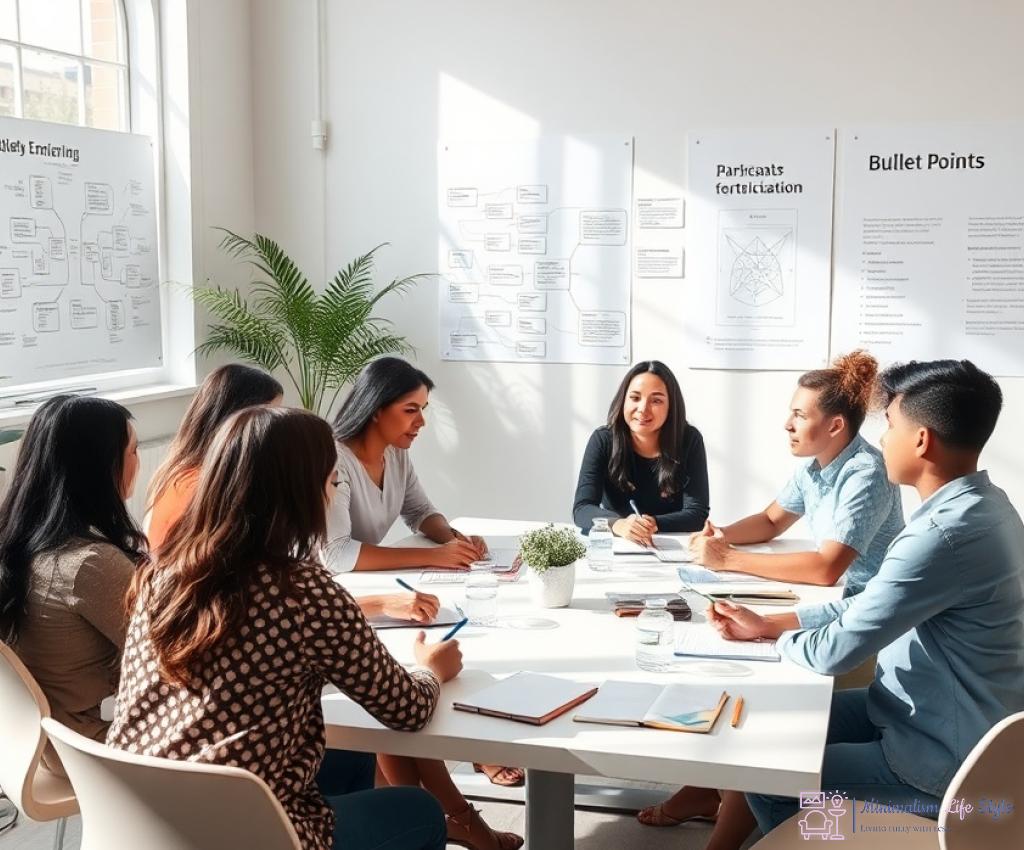Streamlined Learning: The Essence of Minimalism

In the fast-paced world of professional development, the abundance of workshops and training sessions can often feel overwhelming. Many professionals find themselves bombarded with information, leaving them with little time to digest and apply their learnings. This is where minimalism comes into play. By focusing on streamlined learning experiences, we can enhance our professional growth without the clutter.
Minimalism in professional development workshops emphasizes the importance of essential content over excess. Rather than presenting a multitude of topics, streamlined workshops curate a focused experience that facilitates deeper understanding and retention. This approach encourages participants to engage meaningfully with the material, fostering a connection that traditional methods often miss.
Adopting a minimalist approach in workshops not only saves time but also enhances the effectiveness of learning. Here are some of the key benefits:
- Increased Retention: Fewer topics allow for deeper exploration and better retention of information.
- Enhanced Engagement: A focused agenda keeps participants engaged and encourages active participation.
- Practical Application: Streamlined sessions often include hands-on activities that allow for immediate application of concepts.
- Time Efficiency: Less content means shorter sessions, making it easier for busy professionals to fit learning into their schedules.
To successfully integrate minimalism into professional development workshops, facilitators can follow these steps:
- Identify Core Objectives: Clearly define what participants should achieve by the end of the workshop.
- Simplify Content: Cut down on non-essential topics and focus on what truly matters.
- Encourage Interaction: Foster a learning environment that encourages questions and discussions.
- Utilize Technology Wisely: Leverage digital tools to enhance learning without overwhelming participants.
- Gather Feedback: Post-workshop feedback helps refine future sessions for continuous improvement.
In conclusion, minimalism in professional development workshops is not just a trend; it is a necessary evolution in how we approach learning. By focusing on streamlined experiences, we unlock the potential for profound growth and understanding in our professional journeys.
Curating Content: Essentials for Impactful Workshops

In the realm of professional development, the art of curating content is crucial to delivering impactful workshops. It involves carefully selecting the right material that resonates with participants, enabling them to grasp the essential concepts while avoiding cognitive overload. This process requires a keen understanding of the audience’s needs, allowing facilitators to craft a core message that aligns with their expectations and aspirations.
To achieve this, workshop leaders should begin by conducting thorough research on the participants’ backgrounds and professional goals. By identifying common challenges and opportunities within the group, facilitators can tailor the learning experience to focus on relevant topics that will spark interest and engagement.
Another critical aspect of curating content is striking the right balance between depth and brevity. While it may be tempting to include a wide array of topics to showcase expertise, minimalist workshops thrive on the premise that less is more. Prioritizing a few key themes allows participants to delve deeper into the subject matter, ensuring they leave with not only knowledge but also practical skills they can apply immediately.
Facilitators should consider using a variety of teaching methodologies—such as interactive discussions, case studies, and hands-on activities—designed to enhance understanding and retention. For example, instead of presenting a long lecture, a workshop could include small group discussions that encourage participants to explore the material collaboratively. This dynamic approach fosters an environment of shared learning, where participants can gain insights from their peers while reinforcing their understanding of the core concepts.
Finally, to ensure that curated content remains impactful, it is vital to measure the effectiveness of the workshop through participant feedback. Gathering insights post-session can provide facilitators with valuable data on what resonated with the audience and what areas require refinement. This ongoing dialogue not only enhances future workshops but also builds a culture of continuous improvement, ensuring that each learning experience becomes increasingly relevant and valuable.
In summary, the essence of curating content in professional development workshops lies in understanding the audience, balancing depth with brevity, and actively seeking feedback to refine the learning experience. By adopting these principles, workshop leaders can create focused, engaging, and impactful learning environments that empower professionals to thrive in their careers.
Engagement Over Exhaustion: Techniques for Focused Participation

In the realm of professional development, the challenge often lies not in the quantity of information presented but in ensuring that participants are truly engaged with the material. As we move towards a minimalist approach in workshops, it becomes imperative to employ techniques that foster genuine participation rather than overwhelming attendees with a barrage of content. The goal is to create an environment where learning is not just a passive experience but an active dialogue, leading to richer understanding and retention.
One effective technique for enhancing engagement is to design interactive learning moments throughout the workshop. This can be achieved by integrating activities that require participants to collaborate, discuss, and apply concepts in real-time. For instance, rather than simply presenting information, facilitators can pose thought-provoking questions that encourage small group discussions. This approach not only helps participants internalize the material but also cultivates a sense of community among peers, making the learning experience more enjoyable and memorable.
In today’s digital age, leveraging technology can significantly elevate participant engagement. Tools such as live polling, interactive presentations, and virtual breakout rooms allow for immediate feedback and interaction, breaking the monotony of traditional lecture formats. By incorporating these elements, facilitators can create a dynamic atmosphere where participants feel invested in the learning process. Moreover, utilizing multimedia resources can cater to different learning styles, ensuring that visual, auditory, and kinesthetic learners alike find value in the content being presented.
Another crucial aspect of promoting focused participation is the emphasis on reflection and application. Allowing time for participants to reflect on what they have learned and how they can implement these insights in their professional lives fosters a deeper connection to the material. This can be facilitated through guided reflection sessions, where participants are encouraged to articulate their thoughts and experiences related to the workshop’s content. Such practices not only reinforce learning but also empower individuals to take ownership of their development journey.
In summary, by adopting techniques that prioritize engagement over exhaustion, professional development workshops can transform into vibrant, interactive experiences. Through the creation of collaborative learning moments, strategic use of technology, and a focus on personal application, facilitators can ensure that each participant walks away not only with knowledge but also with a renewed sense of enthusiasm for their professional growth.
Measuring Success: Metrics for Minimalist Workshops
In the quest for streamlined learning experiences, the definition of success in minimalist workshops goes beyond mere attendance rates or completion percentages. It is essential to identify metrics that reflect the true impact of these focused sessions on participants’ professional growth. By establishing clear criteria for success, facilitators can not only enhance their workshops but also provide tangible value to the attendees.
To evaluate the effectiveness of minimalist workshops, several key metrics can be considered. These metrics help in understanding participant engagement, knowledge retention, and overall satisfaction with the learning experience. Below is a structured list of metrics that can be employed:
- Participant Feedback: Collecting qualitative and quantitative feedback through surveys post-workshop helps gauge the perceived value and relevance of the content.
- Knowledge Retention Rates: Implementing pre- and post-assessment tests can provide insights into how much information participants have retained.
- Engagement Levels: Monitoring participation in discussions, interactive activities, and Q&A sessions can indicate the level of engagement.
- Application of Skills: Following up with participants to assess how they have implemented learned concepts in their workplace can demonstrate practical impact.
- Net Promoter Score (NPS): This metric assesses participants’ likelihood to recommend the workshop to peers, providing a benchmark for overall satisfaction.
To further illustrate the importance of these metrics, the following table summarizes the key metrics alongside their significance and data collection methods:
| Metric | Significance | Data Collection Method |
|---|---|---|
| Participant Feedback | Measures perceived value and relevance | Post-workshop surveys |
| Knowledge Retention Rates | Assesses learning effectiveness | Pre and post-assessment tests |
| Engagement Levels | Indicates active participation | Observation and participation tracking |
| Application of Skills | Demonstrates practical impact on work | Follow-up interviews or surveys |
| Net Promoter Score (NPS) | Reflects overall satisfaction | Post-workshop surveys |
By closely monitoring these metrics, workshop facilitators can gain a comprehensive understanding of the effectiveness of their minimalist approach. These insights not only inform future workshops but also enhance the overall professional development landscape, ensuring that learning experiences remain relevant, engaging, and impactful.
Sustaining Growth: Minimalism Beyond the Workshop
As we delve deeper into the concept of minimalism in professional development workshops, it becomes evident that the journey does not end when the session concludes. To truly harness the power of focused learning experiences, it is vital to explore how to sustain the growth participants achieve during these workshops. This requires a strategic approach that extends beyond the confines of the workshop room, creating a continuous learning environment that supports ongoing professional development.
Fostering a Culture of Continuous Learning is essential for maintaining momentum after a minimalist workshop. Organizations must encourage an atmosphere where knowledge sharing is not just encouraged but celebrated. This can be achieved through regular team meetings where participants are invited to share their insights, lessons learned, and practical applications of the skills they have acquired. By fostering this culture, organizations can ensure that the learning experience becomes ingrained in the day-to-day operations, transforming knowledge into action.
Integrating Minimalist Principles into Daily Practice is another effective strategy for sustaining growth. Participants should be encouraged to apply minimalist principles in their everyday work. This means prioritizing tasks, eliminating unnecessary commitments, and focusing on the core objectives that drive results. As they begin to streamline their workflows, they will not only enhance their productivity but also reinforce the key concepts learned during the workshop. Organizations can support this integration by providing resources such as guides, templates, and checklists that embody minimalist practices, making it easier for individuals to adopt these habits.
Furthermore, establishing an Accountability Framework can greatly assist in sustaining growth. Participants can form small groups or pairs to maintain accountability for applying what they’ve learned. Regular check-ins can be scheduled to discuss progress, challenges, and new insights. This collaborative approach not only fosters a sense of community but also allows individuals to learn from each other’s experiences, reinforcing the principles of minimalism in their professional journeys.
| Strategy | Description |
|---|---|
| Fostering a Culture of Continuous Learning | Encourage knowledge sharing and celebrate insights gained from workshops. |
| Integrating Minimalist Principles | Apply minimalist practices to streamline workflows and focus on core objectives. |
| Establishing an Accountability Framework | Create small groups for check-ins and sharing progress on applying learned concepts. |
By adopting these strategies, organizations can create a robust framework for sustaining growth that extends well beyond the workshop experience. The essence of minimalism in professional development lies not only in the initial learning but in the continuous evolution of skills and knowledge that empower professionals to thrive in their careers.




